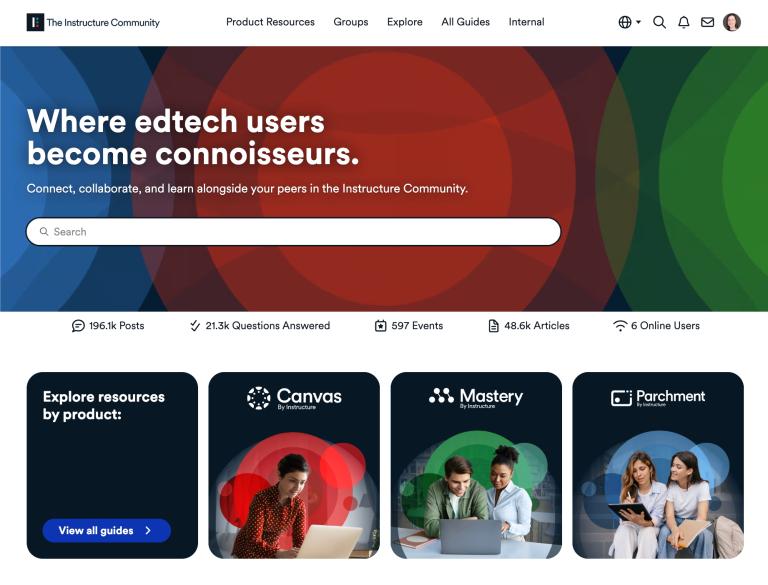Disconnection. Disengagement. Unmet needs.
Chronic absenteeism is one of the most complex challenges districts face today. No single tool or tactic can fix it, but there are ways districts can respond with greater intention, empathy, and coordination.
Here are five ways to support your district’s efforts, along with ideas for how digital tools like Canvas LMS and Mastery Connect can help educators and families work together to re-engage students, reconnect with families, and keep learning moving forward.
1. Keep Students Connected to Learning, Even When They're Absent
Sometimes, absence is unavoidable. But learning doesn’t have to stop. Asynchronous access to lessons, materials, and assignments allows students to stay engaged while away from school and helps them return without feeling lost.
Canvas LMS creates a consistent digital home base where students can continue learning at their own pace. Students have flexible options to stay engaged:
- watch a recorded lesson
- participate in an online discussion
- check their understanding in quick, formative assessments
- collaborate via chat, video, and other messaging tools
Mastery Paths in Canvas can further personalize this experience by delivering differentiated content based on students’ performance, so those returning from absences receive the right level of challenge or support.
✅ Support tip: Consider using differentiation tags or student groups in Canvas to organize different supports for students who need extra time, review, or enrichment.
2. Strengthen Communication with Families and Support Networks
Schools can address absenteeism with passion and resources, but without engaging the community and families, impactful changes aren't likely to occur. Family involvement can be foundational to student success, but keeping families informed and engaged is critical, especially when absences begin to add up.
Canvas makes it easier to reach out to both students and their observers (like parents or guardians) in a single message. Educators build trust and reinforce partnerships with families through consistent communication like:
- sharing encouraging progress
- flagging a concern
- looping in a counselor or interventionist
- highlighting a positive SEL incident
The Message Students Who feature makes it easy to tailor communication to those who need the most support. Additionally, the Canvas Parent App enables parents and guardians to stay connected to their student’s performance at all times. Parents can review upcoming or past assignments, check on grades, and receive alerts for student activity.
✅ Support tip: Support educators with templates or guidelines for empathetic outreach that centers on students’ well-being.
3. Identify Early Signs Before Absenteeism Escalates
The signs of disengagement often show up in learning before they show up in attendance records. Early signals that a student is struggling could include:
- changes in participation
- missing assignments
- sudden dips in performance
- shifts in attitude towards learning
Canvas Intelligent Insights enables self-service analytics and proactively surfaces actionable insights that inform strategic initiatives to improve course and edtech effectiveness, student retention, and graduation rates. The Students in Need of Attention feature highlights students who may need attention based on performance trends, empowering educators to take action sooner rather than later.
✅ Support tip: Consider building time into PLCs or staff meetings for educators to review trends and collaborate on early interventions.
4. Help Educators Understand Where Students Are Academically
When students miss school, learning gaps can emerge quickly. But before jumping into catch-up plans, educators need clarity on what was missed and what students still know.
Using a standards-aligned approach to formative assessment–supported by tools like Mastery Connect–can help teachers get a clear snapshot of a student’s current understanding so that they can quickly identify strengths and areas for additional support and quickly make plans for additional instruction.
Follow-up assessment tools, like Quick Reassess in Mastery Connect, enable educators to create assessments to efficiently measure student progress after an intervention using high-quality, standards-aligned items from the Mastery Item Bank. This timely feedback helps close learning gaps more quickly and gives teachers a clear view of where students are, every step of the way.
✅ Support tip: Encourage the use of quick, low-stakes formative assessments that help teachers tailor instruction based on what students know and not just what they missed.
5. Collaborate Around Data to Plan Targeted Support
Not all students who miss class need the same kind of help. One may need a full reteach, while another just needs a short review. The key is finding the balance between offering meaningful support and maintaining instructional momentum without overburdening educators or overwhelming students.
Predictive benchmark assessments, like the Mastery Predictive Assessments and Mastery College Prep Assessments, provide educators with a forward-looking view of how students will likely perform on end-of-year summative assessments. This kind of insight helps schools shift from reactive to proactive support planning.
Within Professional Learning Communities (PLCs), these insights can be especially powerful. By reviewing student performance on common benchmark and formative assessments together, educators can identify trends across classrooms, surface bright spots where specific strategies or interventions are working, and co-develop targeted plans for reteaching, remediation, or enrichment. Whether it's pulling a small group, offering a one-on-one mini-lesson, or streamlining what content actually needs review, collaborative, data-informed planning helps make intervention more manageable and effective.
✅ Support tip: Use PLC time to look for trends in student performance on common assessments, highlight bright spots where interventions are working, and collaboratively plan the next steps for targeted support.
Supporting the Whole Student, Together
Absenteeism signals that a student might be struggling, disconnected, or needing a different kind of support. Tools like Canvas LMS and Mastery Connect aren’t a silver bullet, but they can help educators, families, and support teams stay in sync and surround students with the resources they need to thrive.
Let’s continue supporting each other as we navigate this challenge because every day a student is in school and engaged is a step toward brighter outcomes.
Related Content
 inst-3step.jpg
inst-3step.jpgBlogs
 13lmsfeaturesthatbenefitstudentlearning.jpg
13lmsfeaturesthatbenefitstudentlearning.jpgBlogs
 community-homepage.jpg
community-homepage.jpgBlogs
